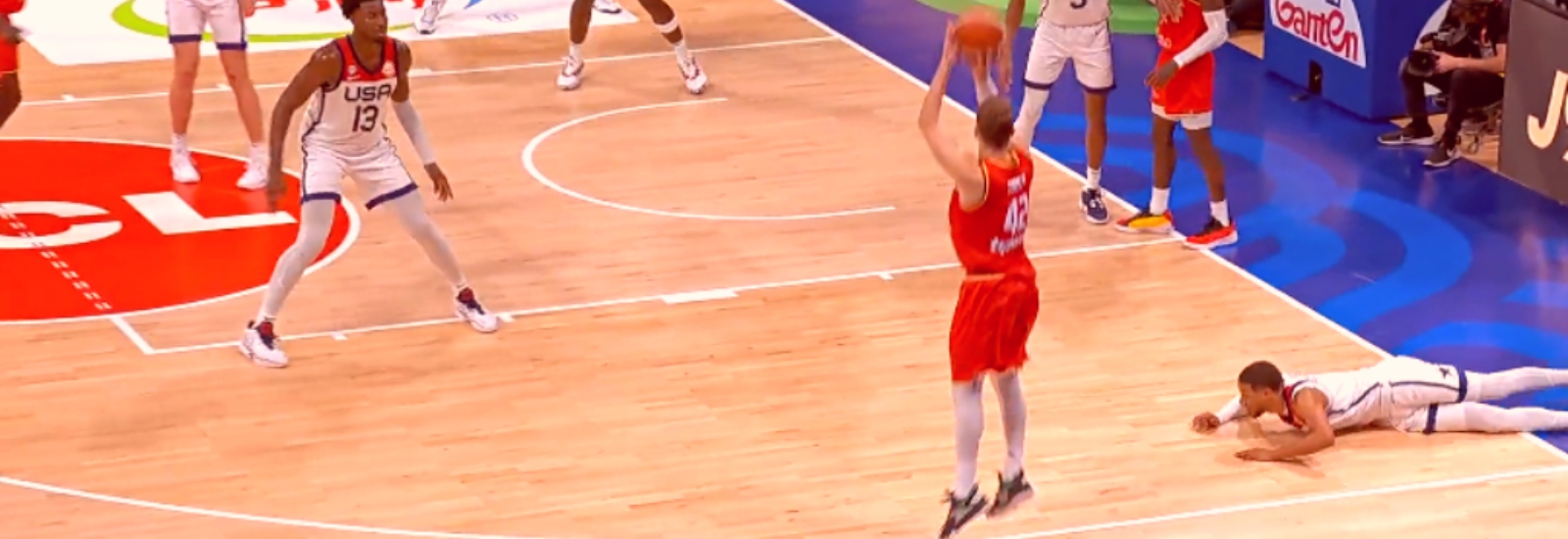Midway through the second quarter of Friday’s FIBA World Cup semifinal between Germany and the United States, Daniel Theis attempted to float an entry pass inside to Johannes Thiemann, who held an advantage against the smaller Mikal Bridges. Except, Bobby Portis interrupted Theis’ plans and deflected the pass, which caromed toward Isaac Bonga. Immediately and without hesitation, the lanky German forward redirected the ball into Thiemann’s clutches and helped Germany knot the score at 41.
While the sequence marked Bonga’s lone assist of the evening during a game his preeminent contributions occurred defensively, it also revealed a few themes central to Germany’s 113-111 victory over the U.S. that propelled it into Sunday’s title game against Serbia.
Often deploying some trio involving Thiemann, Theis, Franz Wagner, Moritz Wagner, and Johannes Voigtmann, Germany constantly leveraged its size advantage to success, whether that be scoring at the rim, generating second chances or commanding double teams to produce fruitful looks elsewhere. It trotted out some massive quintets. USA’s interior depth is scarce, and an aversion to consistent two-big lineups or minutes for Walker Kessler only heightened that dilemma and gulf. Germany nabbed five more offensive rebounds and scored six more points in the paint than the Americans on Friday.
The gap in passing quality announced itself from the outset as well, reinforced by Germany’s 73.2 percent assist rate compared to USA’s 65.8 percent. Bonga’s improvisation to keep the offense humming provided a snapshot of how his side hung 113 points on its counterparts in a 40-minute game.
The shot-making numbers — 68.3 percent (28-of-41) inside the arc, 43.3 percent (13-of-30) beyond it — are eye-catching, but Germany routinely yielded high-quality attempts all over the floor because of its decisive, savvy passing. Beyond a stretch late in the fourth quarter when USA dialed up the contact point and physicality on switches and stalled the action a handful of times, Germany was a multifaceted juggernaut offensively. Its cohesion and connectivity were joys to watch.
Individually, names like Dennis Schroder and Franz Wagner rightfully headline this squad. Both of them played well Friday. Schroder conducted the offense masterfully and discerningly, logging 17 points (7-of-13 shooting) and nine assists to zero turnovers. Wagner thrived in transition and notched 22 points (7-of-18 shooting), five boards, two assists, and one steal.
Yet the semifinal stars were Theis and Andreas Obst. Nobody played better than them. Theis was the foremost star. In 28 minutes, he slapped down 21 points (10-of-15 shooting), seven rebounds, two assists, one steal and one block. His perimeter comfort on both ends was integral to Germany’s jumbo lineups. When they needed him to operate above the break as a floor-spacer or outside-in passing hub, he obliged. When he was thrust into pick-and-rolls, he converted. When he was the low man defensively, he rotated punctually. When he had to stunt or defend the ball-handler, he didn’t look out of sorts. His two-way fluidity popped.
Protecting the rim, attacking closeouts, providing diverse play-finishing, and looking sprightly in space, the 31-year-old cast an imprint in a multitude of facets. He blended his traditional NBA role player duties with heightened freedom this national team environment affords him. Never did it feel as though he had to impose himself, but he was always around, guiding Germany toward the gold medal game.
Helping lead that charge alongside Theis was Obst, whose sidestep triple with 75 seconds remaining served as the biggest shot of the night and dumped water on the fire of USA’s late, furious push. Obst scored a team-high 24 points on 6-of-11 shooting and added six dimes. Among screens into jumpers, drives, and second-side actions, Germany prioritized scheming him touches in motion. USA tried stashing Tyrese Haliburton and Jalen Brunson on Obst. That gambit was completely exploited. Their struggles with screen navigation continually rendered them a liability, underlined the roster’s shaky guard defense, and enabled Obst to thrive.
After he buried a couple long balls early in the first quarter, USA emphasized skirting him off the arc and forcing him to put the ball on the deck. That didn’t quiet him. His processing and playmaking were sharp counters whenever defenders keyed in on his scoring genes. Once he elected to pass, the ball really snapped out of his hand and left opponents scant time to rotate or recover.
The jumper, of course, is a marvel. There’s no wasted movement; it’s beautiful. He’s netted 16-of-35 threes in the tournament, including 4-of-8 in the semifinals. According to Basketball-Reference, on 501 cataloged attempts since 2014-15, he’s drilled 41.3 percent of them. He’s just an absolute marksman who showed out at a pivotal moment and was not confined to outside shooting as a means of impact.
As another World Cup reaches a conclusion without Team USA hoisting the trophy, focus from many crowds understandably shifts to limitations of the roster and how they can be remedied heading into next summer’s Olympics. To fixate solely on those angles, though, would be to disregard everything Germany excelled at on Friday.
That result is also a testament to what Germany has built with this group. The offensive schematics and synergy are tremendous. The personnel is well-constructed. Its top players fill many different gaps and do not overlap in infringing ways. All of that was on display as it dispatched USA and now stands on the precipice of its first World Cup title in team history.







